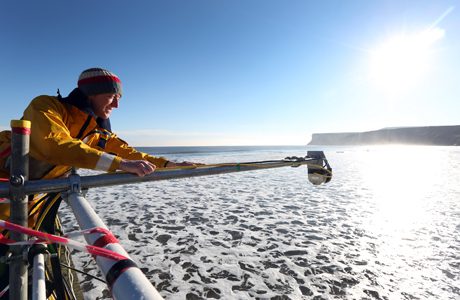
An international research project led by the University of Bath is investigating the impact of waves on coastlines using novel laser measurement devices.
This innovative equipment is similar to laser measurement devices used in construction, except it is able to measure 37,500 points a second. This capability means these ‘Lidar’ devices are able to scan each individual wave as it breaks and measure the changing elevation of the water surface.
This technology is mounted above the water level to structures such as piers and can produce an animation of the breaking waves as well as calculating the amount of sand being displaced from the waves.
Dr Chris Blenkinsopp from the University of Bath’s Water Innovation & Research Centre (WIRC @ Bath) is leading the project team which includes international colleagues from The University of Newcastle, Australia, and the University of Delaware, USA.
The Waves in Shallow Water (WASH) project has been funded by a £100,000 Engineering and Physical Sciences Research Council (EPSRC) grant in which the research team are measuring the effect of breaking waves in in two very different locations – in Saltburn in Northwest England and Valparaiso in Chile.
The findings of this research will benefit environment agencies, coastal engineers and local councils of coastal towns as well as local residents who live on the coast. The results and insight will help better understand the behaviour and power of waves and in turn allow more accurate estimations of the wave force on coastal defence structures; predict erosion rates on beaches, cliffs and dunes; and forecast coastal flooding.
In recent years the UK has experienced the negative effects of wave power, most notably the destruction of the coastal railway line through Dawlish in Devon in 2014 and North Sea tidal surge in 2013. In Devon, the power from waves during the winter storms washed away the track and took two months to rebuild courtesy of a 300-strong Network Rail team at a cost of £35m.
It is hoped that the results of the project will enable relevant authorities to better predict any future risks from wave power and improve the resilience of coastal management, as well as ensuring the maintenance of beaches is informed and effective.
Senior Lecturer in the Department of Architecture & Civil Engineering and project lead, Dr Blenkinsopp said: “This is a really exciting project that will enable us to better understand not only the individual and cumulative force of waves over time, but also their impact on coastal defences, beaches and cliffs, and erosion rates.
“We have seen the damage the power of waves can cause and it is hoped that the results of this research will inform the models used by coastal engineers in the future allowing them to more effectively design coastal structures and plan coastal defences.”






